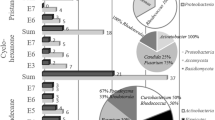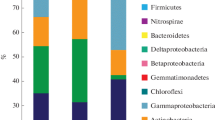Abstract
Different abandoned industrial areas contaminated by polycyclic aromatic hydrocarbons (PAHs) are present in Slovakia. These environmental burdens are very dangerous to the health of human and environment. The bioremediation, based on the use of hydrocarbons degrading microorganisms, is a promising strategy to sanitize these polluted sites. The aim of this investigation was to assess the bacterial diversity of a PAHs-contaminated soil and to select the potential hydrocarbonoclastic bacteria which can be used for different bioremediation approaches. The bacterial strains were isolated on minimal medium agar supplemented with a mixture of PAHs. Seventy-three isolated strains were grouped by ribosomal interspacer analysis in 15 different clusters and representatives of each cluster were identified by 16S rRNA sequencing. The PAHs degradation abilities of all bacterial isolates were estimated by the 2,6-dichlorophenol indophenol assay and by their growth on minimal broth amended with a mixture of PAHs. Different kinds of strains, members of the genus Pseudomonas, Enterobacter, Bacillus, Arthrobacter, Acinetobacter and Sphingomonas, were isolated from the contaminated soil. Four isolates (Pseudomonas putida, Arthrobacter oxydans, Sphingomonas sp. and S. paucimobilis) showed promising PAHs-degrading abilities and therefore their possible employing in bioremediation strategies.
Similar content being viewed by others
Abbreviations
- PAH:
-
polycyclic aromatic hydrocarbon
- RISA:
-
ribosomal interspacer analysis
- 2,6-DCPIP:
-
2,6-dichlorophenol indophenol
- MM:
-
minimal medium
References
Abd-Elsalam H.E., Hafez E.E., Hussain A.A., Ali A.G. & El-Hanafy A.A. 2009. Isolation and identification of three-rings polyaromatic hydrocarbons (anthracene and phenanthrene) degrading bacteria. Am. Eurasian J. Agric. Environ. Sci. 5: 31–38.
Altschul S.F., Gish W., Miller W., Myers E.W. & Lipman D.J. 1990. Basic local alignment search tool. J. Mol. Biol. 215: 403–410.
Arun A., Raja P.P., Arthi R., Ananthi M., Kumar K.S. & Eyini M. 2008. Polycyclic aromatic hydrocarbons (PAHs) biodegradation by basidiomycetes fungi, Pseudomonas isolate, and their cocultures: comparative in vivo and in silico approach. Appl. Biochem. Biotechnol. 151: 132–42.
Augustynowicz J., Kaszycki P., Ku’s M., Białecka A. & Kołoczek H. 2008. Optimized methods for stabilization of microbial communities specializing in biodegradation of organic environmental contaminants. Pol. J. Environ. Stud. 17: 655–664.
Bandowe B.A.M., Sobocka J. & Wilcke W. 2011. Oxygencontaining polycyclic aromatic hydrocarbons (OPAHs) in urban soils of Bratislava, Slovakia: patterns, relation to PAHs and vertical distribution. Environ. Pollut. 159: 539–549.
Belgacem Z.B., Dousset X., Prévost H. & Manai M. 2009. Polyphasic taxonomic studies of lactic acid bacteria associated with Tunisian fermented meat based on the heterogeneity of the 16S–23S rRNA gene intergenic spacer region. Arch. Microbiol. 191: 711–720.
Ben Said O., Goni-Urriza M.S., El Bour M., Dellali M., Aissa P. & Duran R. 2008. Characterization of aerobic polycyclic aromatic hydrocarbon-degrading bacteria from Bizerte lagoon sediments, Tunisia. J. Appl. Microbiol. 104: 987–997.
Bissey L.L., Smith J.L. & Watts R.J. 2006. Soil organic matterhydrogen peroxide dynamics in the treatment of contaminated soils and groundwater using catalyzed H2O2 propagations (modified Fenton’s reagent). Water Res. 40: 2477–2484.
Doong R. & Lei W. 2003. Solubilization and mineralization of polycyclic aromatic hydrocarbons by Pseudomonas putida in the presence of surfactant. J. Hazard. Mater. 96: 15–27.
Ferrarese E., Andreottola G., & Oprea I.A. 2008. Remediation of PAH contaminated sediments by chemical oxidation. J. Hazard. Mater. 152: 128–139.
Gallego J., García-Martínez M., Llamas J., Belloch C., Peláez A. & Sánchez J. 2007. Biodegradation of oil tank bottom sludge using microbial consortia. Biodegradation 18: 269–281.
Gan S., Lau E.V. & Ng H.K. 2009. Remediation of soils contaminated with polycyclic aromatic hydrocarbons (PAHs). J. Hazard. Mater. 172: 532–549.
Gong Z., Alef K., Wilke B.M., Mai M. & Li P. 2005. Assessment of microbial respiratory activity of a manufactured gas plant soil after remediation using sunflower oil. J. Hazard. Mater. 124: 217–223.
Gong Z., Wilke B.M., Alef K., Li P. & Zhou Q. 2006. Removal of polycyclic aromatic hydrocarbons from manufactured gas plant-contaminated soils using sunflower oil: laboratory column experiments. Chemosphere 62: 780–787.
González N., Simarro R., Molina M.C., Bautista L.F., Delgado L. & Villa J.A. 2011. Effect of surfactants on PAH biodegradation by a bacterial consortium and on the dynamics of the bacterial community during the process. Bioresour. Technol. 102: 9438–9446.
Grosser R.J., Warshawsky D. & Vestal J.R. 1991. Indigenous and enhanced mineralization of pyrene, benzo[a]pyrene, and carbazolde in soils. Appl. Environ. Microbiol. 57: 3462–3469.
Hallett P.D., White N.A. & Ritz K. 2006. Impact of basidiomycete fungi on the wettability of soil contaminated with a hydrophobic polycyclic aromatic hydrocarbon. Biologia 61(Suppl. 19): S334–S338.
Hanson K.G., Desai J.D. & Desai A.J. 1993. A rapid and simple screening technique for potential crude oil degrading microorganisms. Biotechnol. Tech. 7: 745–748.
Jennings A.A. 2012. Worldwide regulatory guidance values for surface soil exposure to noncarcinogenic polycyclic aromatic hydrocarbons. J. Environ. Manage. 101: 173–190.
Jensen M.A., Webster J.A. & Straus N. 1993. Rapid identification of bacteria on the basis of polymerase chain reactionamplified ribosomal DNA spacer polymorphisms. Appl. Environ. Microbiol. 59: 945–952.
Krajčovičová J. & Eschenroeder A.Q. 2007. Comparative health risks of domestic waste combustion in urban and rural Slovakia. Environ. Sci. Technol. 41: 6847–6853.
Kobayashi T., Murai Y., Tatsumi K. & Iimura Y. 2009. Biodegradation of polycyclic aromatic hydrocarbons by Sphingomonas sp. enhanced by water-extractable organic matter from manure compost. Sci. Total Environ. 407: 5805–5810.
Lane D.J. 1991. 16S/23S rRNA sequencing, pp. 115–148. In: Stackenbrandt E. & Goodfellow M. (eds) Nucleic Acid Techniques in Bacterial Systematics. New York: John Wiley & Sons.
La Rosa G., De Carolis E., Sali M., Papacchini M., Riccardi C., Mansi A., Paba E., Alquati C., Bestetti G. & Muscillo M. 2006. Genetic diversity of bacterial strains isolated from soils, contaminated with polycyclic aromatic hydrocarbons, by 16S rRNA gene sequencing and amplified fragment length polymorphism fingerprinting. Microbiol. Res. 161: 150–157.
Ortega-Calvo J.J., Marchenko A.I., Vorobyov A.V. & Borovick R.V. 2003. Chemotaxis in polycyclic aromatic hydrocarbondegrading bacteria isolated from coal-tar- and oil-polluted rhizospheres. FEMS Microbiol. Ecol. 44: 373–381.
Pangallo D., Harichova J., Karelova E., Drahovska H., Chovanova K., Ferianc P., Turna J. & Timko J. 2004. Molecular investigation of enterococci isolated from different environmental sources. Biologia 59: 829–837.
Rivas F.J. 2006. Polycyclic aromatic hydrocarbons sorbed on soils: a short review of chemical oxidation based treatments. J. Hazard. Mater. 138: 234–251.
Ruggeri C., Franzetti A., Bestetti G., Caredda P., La Colla P., Pintus M., Sergi S. & Tamburini E. 2009. Isolation and characterization of surface active compound-producing bacteria from hydrocarbon-contaminated environments. Int. Biodeterior. Biodegradation 63: 936–942.
Samanta S.K., Singh O.V. & Jain R.K. 2002. Polycyclic aromatic hydrocarbons: environmental pollution and bioremediation. Trends Biotechnol. 20: 243–248.
Shi T., Fredrickson J.K. & Balkwill D.L. 2001. Biodegradation of polycyclic aromatic hydrocarbons by Sphingomonas strains isolated from the terrestrial subsurface. J. Ind. Microbiol. Biotechnol. 26: 283–289.
Silva-Castro G.A., Uad I., Gonzalez-Lopez J., Fandino C.G., Toledo F.L. & Calvo C. 2012. Application of selected microbial consortia combined with inorganic and oleophilic fertilizers to recuperate oil-polluted soil using land farming technology. Clean Technol. Environ. Policy 14: 719–726.
Taylor L.T. & Jones D.M. 2001. Bioremediation of coal tar PAH in soils using biodiesel. Chemosphere 44: 1131–1136.
Thion C., Cébron A., Beguiristain T. & Leyval C. 2012. PAH biotransformation and sorption by Fusarium solani and Arthrobacter oxydans isolated from a polluted soil in axenic cultures and mixed co-cultures. Int. Biodeterior. Biodegradation 68: 28–35.
Urzi C., De Leo F., Bruno L. & Albertano P. 2010. Microbial diversity in paleolithic caves: a study case on the phototrophic biofilms of the Cave of Bats (Zuheros, Spain). Microb. Ecol. 60: 116–129.
Wilcke W., Zech W. & Kobža J. 1996. PAH-pools in soils along a PAH-deposition gradient. Environ. Pollut. 92: 307–313.
Author information
Authors and Affiliations
Corresponding author
Rights and permissions
About this article
Cite this article
Puškárová, A., Bučková, M., Chovanová, K. et al. Diversity and PAH growth abilities of bacterial strains isolated from a contaminated soil in Slovakia. Biologia 68, 587–591 (2013). https://doi.org/10.2478/s11756-013-0193-3
Received:
Accepted:
Published:
Issue Date:
DOI: https://doi.org/10.2478/s11756-013-0193-3




